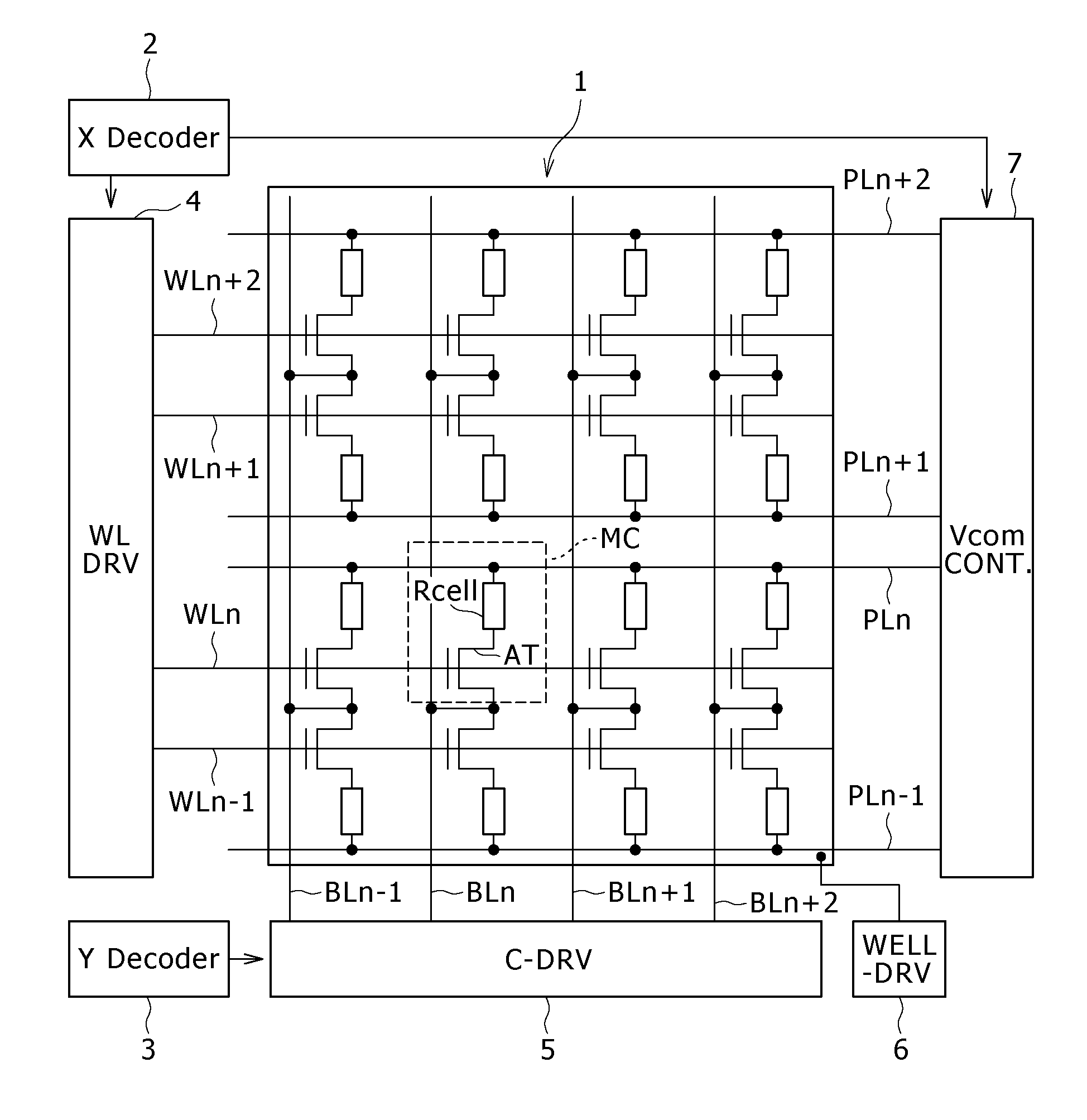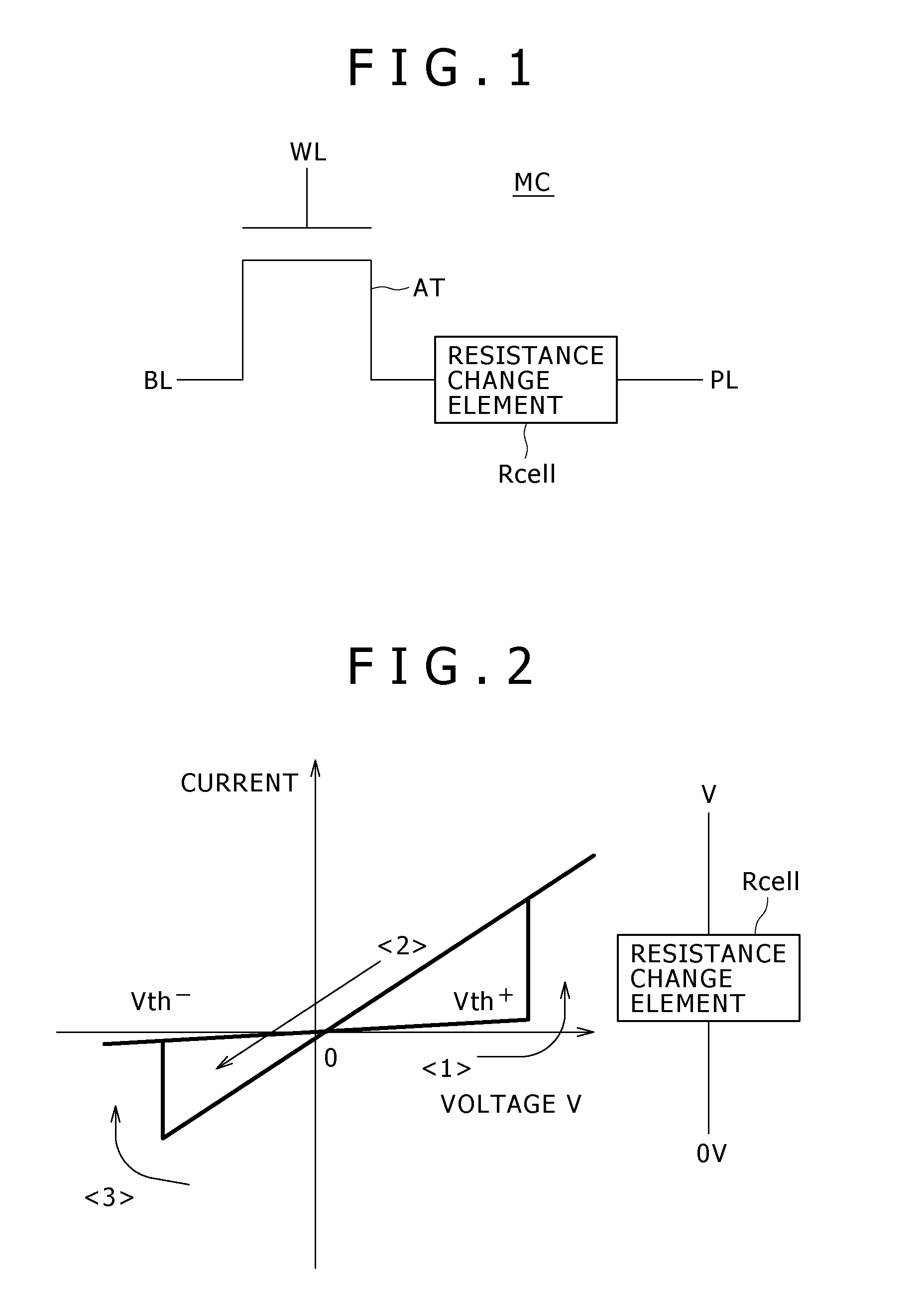Resistance change memory device and operation method of the same
- Summary
- Abstract
- Description
- Claims
- Application Information
AI Technical Summary
Benefits of technology
Problems solved by technology
Method used
Image
Examples
first embodiment
1. Embodiment in which an arbitrary configuration is used to supply a well voltage
2. Second embodiment: Embodiment in which a configuration is shown to supply a well voltage
3. Modification example
1. First Embodiment
Memory Cell Configuration
[0041]FIG. 1 is an equivalent circuit diagram of a memory cell according to an embodiment of the present invention.
[0042]A memory cell MC illustrated in FIG. 1 includes a variable cell resistor Rcell and an access transistor AT. The variable cell resistor Rcell serves as a “memory element.”
[0043]The variable cell resistor Rcell has one end connected to a plate line PL, and the other end to the source of the access transistor AT. The access transistor AT has its drain connected to a bit line BL and its gate to a word line WL. The word line WL serves as an “access line.”
[0044]Here, the bit line BL corresponds to an example of a “first wiring,” and the plate line PL to an example of a “second wiring.” Further, the plate line PL may be an example of ...
second embodiment
2. Second Embodiment
[0129]In a second embodiment, a well voltage supply structure is proposed which is effective in providing reduced well resistance for reduced variation in voltage applied to the storage element.
[0130]FIG. 12 illustrates a circuit diagram of the memory cell array according to the second embodiment.
[0131]The memory cell according to the second embodiment differs from that according to the first embodiment shown in FIGS. 6 to 11 in that well bias supply lines WBLx and WBLy shown in FIG. 12 are added. The well bias supply lines WBLx and WBLy are mainly arranged in the x (row) and y (column) directions. At least one of the well bias supply lines WBLx and WBLy is enough to supply a well bias. Here, however, a case is illustrated in which the well bias supply lines are arranged in a grid pattern for the P well 100P.
[0132]The well bias supply lines WBLx and WBLy need only be electrically connected to the P well 100P and include a conductor layer or a conductor region hav...
modification example
3. Modification Example
[0144]The access transistor AT and variable cell resistor Rcell shown in FIG. 1 may be interchanged. That is, the access transistor AT may be connected to the plate line PL, and the variable cell resistor Rcell connected directly to the bit line BL.
[0145]It should be noted, however, that the potential of the bit line BL frequently undergoes a significant change during operation. Therefore, the configuration shown in FIG. 1 is preferred because the effect of such a voltage change can be shut off by the access transistor AT in an OFF state (unselected).
[0146]Further, the set operation (transition from a high to low resistance state) was treated as the write operation, and the reset operation (transition from a low to high resistance state) as the erase operation. However, the set operation may be treated as the erase operation, and the reset operation as the write operation.
[0147]If the access transistor AT is formed with a P-type transistor, an N-type well (N w...
PUM
 Login to View More
Login to View More Abstract
Description
Claims
Application Information
 Login to View More
Login to View More - Generate Ideas
- Intellectual Property
- Life Sciences
- Materials
- Tech Scout
- Unparalleled Data Quality
- Higher Quality Content
- 60% Fewer Hallucinations
Browse by: Latest US Patents, China's latest patents, Technical Efficacy Thesaurus, Application Domain, Technology Topic, Popular Technical Reports.
© 2025 PatSnap. All rights reserved.Legal|Privacy policy|Modern Slavery Act Transparency Statement|Sitemap|About US| Contact US: help@patsnap.com



